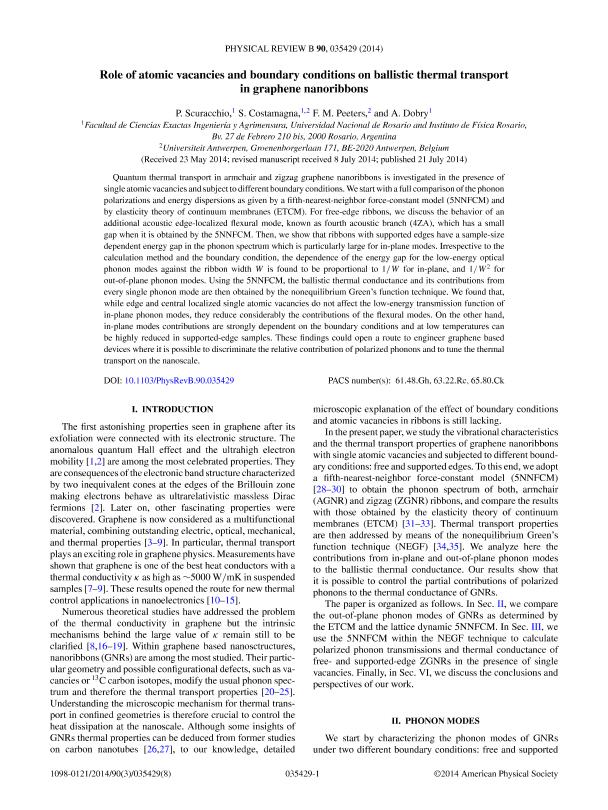Mostrar el registro sencillo del ítem
dc.contributor.author
Scuracchio, Pablo Martín

dc.contributor.author
Costamagna, Sebastian

dc.contributor.author
Peeters, F. M.
dc.contributor.author
Dobry, Ariel Oscar

dc.date.available
2016-06-15T18:26:40Z
dc.date.issued
2014-07
dc.identifier.citation
Scuracchio, Pablo Martín; Costamagna, Sebastian; Peeters, F. M. ; Dobry, Ariel Oscar; Role of atomic vacancies and boundary conditions on ballistic thermal transport in graphene nanoribbons; American Physical Society; Physical Review B: Condensed Matter and Materials Physics; 90; 7-2014; 35429-35429
dc.identifier.issn
0556-2805
dc.identifier.uri
http://hdl.handle.net/11336/6190
dc.description.abstract
Quantum thermal transport in armchair and zigzag graphene nanoribbons is investigated in the presence of single atomic vacancies and subject to different boundary conditions. We start with a full comparison of the phonon polarizations and energy dispersions as given by a fifth-nearest-neighbor force-constant model (5NNFCM) and by elasticity theory of continuum membranes (ETCM). For free-edge ribbons, we discuss the behavior of an additional acoustic edge-localized flexural mode, known as fourth acoustic branch (4ZA), which has a small gap when it is obtained by the 5NNFCM. Then, we show that ribbons with supported edges have a sample-size dependent energy gap in the phonon spectrum which is particularly large for in-plane modes. Irrespective to the calculation method and the boundary condition, the dependence of the energy gap for the low-energy optical phonon modes against the ribbon width W is found to be proportional to 1/W for in-plane, and 1/W2 for out-of-plane phonon modes. Using the 5NNFCM, the ballistic thermal conductance and its contributions from every single phonon mode are then obtained by the nonequilibrium Green´s function technique. We found that, while edge and central localized single atomic vacancies do not affect the low-energy transmission function of in-plane phonon modes, they reduce considerably the contributions of the flexural modes. On the other hand, in-plane modes contributions are strongly dependent on the boundary conditions and at low temperatures can be highly reduced in supported-edge samples. These findings could open a route to engineer graphene based devices where it is possible to discriminate the relative contribution of polarized phonons and to tune the thermal transport on the nanoscale.
dc.format
application/pdf
dc.language.iso
eng
dc.publisher
American Physical Society

dc.rights
info:eu-repo/semantics/openAccess
dc.rights.uri
https://creativecommons.org/licenses/by-nc-sa/2.5/ar/
dc.subject
Graphene
dc.subject
Thermal Conductivity
dc.subject
Nanoribbons
dc.subject
Ballistic
dc.subject.classification
Física de los Materiales Condensados

dc.subject.classification
Ciencias Físicas

dc.subject.classification
CIENCIAS NATURALES Y EXACTAS

dc.title
Role of atomic vacancies and boundary conditions on ballistic thermal transport in graphene nanoribbons
dc.type
info:eu-repo/semantics/article
dc.type
info:ar-repo/semantics/artículo
dc.type
info:eu-repo/semantics/publishedVersion
dc.date.updated
2016-06-10T18:39:40Z
dc.journal.volume
90
dc.journal.pagination
35429-35429
dc.journal.pais
Estados Unidos

dc.journal.ciudad
New York
dc.description.fil
Fil: Scuracchio, Pablo Martín. Consejo Nacional de Investigaciones Científicas y Técnicas. Centro Científico Tecnológico Rosario. Instituto de Física de Rosario (i); Argentina. Universidad Nacional de Rosario. Facultad de Ciencias Exactas, Ingeniería y Agrimensura; Argentina
dc.description.fil
Fil: Costamagna, Sebastian. Consejo Nacional de Investigaciones Científicas y Técnicas. Centro Científico Tecnológico Rosario. Instituto de Física de Rosario (i); Argentina. Universidad Nacional de Rosario. Facultad de Ciencias Exactas, Ingeniería y Agrimensura; Argentina. Universiteit Antwerpen; Bélgica
dc.description.fil
Fil: Peeters, F. M.. Universiteit Antwerpen; Bélgica
dc.description.fil
Fil: Dobry, Ariel Oscar. Universidad Nacional de Rosario. Facultad de Ciencias Exactas, Ingeniería y Agrimensura; Argentina. Consejo Nacional de Investigaciones Científicas y Técnicas. Centro Científico Tecnológico Rosario. Instituto de Física de Rosario (i); Argentina
dc.journal.title
Physical Review B: Condensed Matter and Materials Physics

dc.relation.alternativeid
info:eu-repo/semantics/altIdentifier/url/http://journals.aps.org/prb/abstract/10.1103/PhysRevB.90.035429
dc.relation.alternativeid
info:eu-repo/semantics/altIdentifier/doi/10.1103/PhysRevB.90.035429
dc.relation.alternativeid
info:eu-repo/semantics/altIdentifier/doi/http://dx.doi.org/10.1103/PhysRevB.90.035429
dc.relation.alternativeid
info:eu-repo/semantics/altIdentifier/url/http://arxiv.org/abs/1407.6048v1
dc.relation.alternativeid
info:eu-repo/semantics/altIdentifier/arxiv/1407.6048v1
Archivos asociados
